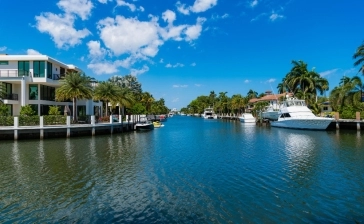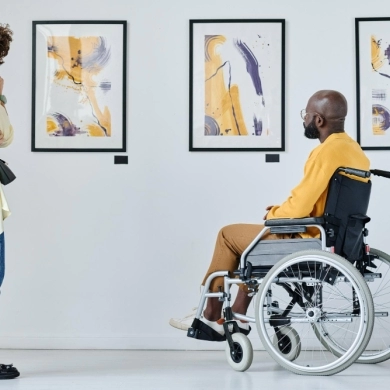Welcome to Miami, a vibrant city known for its sunny beaches, rich cultural diversity, dynamic art scene, and, of course, as one of the world's leading cruise destinations.
This destination, famous for being a melting pot of cultures, offers a unique experience for all visitors, including those traveling in wheelchairs.
Located in South Florida, Miami is a tropical paradise known for its vibrant culture, magnificent beaches, and a welcoming atmosphere that invites you to explore every corner. For a wheelchair-bound tourist, Miami is not just an accessible destination but a place full of opportunities to enjoy a limitless vacation experience.
Since its roots, Miami has been a melting pot of cultures. Founded in 1896, it has grown from a small settlement to a bustling metropolis, home to a rich blend of Latin American, Caribbean, and North American influences. This diversity is reflected not only in its people but also in its architecture, art, and gastronomy. The streets of Miami pulsate with the energy of multiple languages, music ranging from jazz to salsa, and a culinary scene that offers everything from exquisite Cuban dishes to sophisticated international dining experiences.
For the wheelchair traveler, Miami is surprisingly accessible. The famous beaches of Miami, such as South Beach, are an excellent example of this. With ramps and paved paths leading directly to the shore, and special wheelchairs available for those who want to feel the sand under their wheels, the sea becomes accessible to everyone. In addition, the iconic Ocean Drive, with its vibrant nightlife and Art Deco buildings, is perfectly equipped to welcome visitors with various mobility needs.
Art and culture are pillars of the Miami experience. The Pérez Art Museum Miami, with its stunning exhibitions of modern and contemporary art, is completely accessible, as is the lively Wynwood Arts District, known worldwide for its large murals and art galleries. For nature lovers, the Everglades National Park offers a unique experience with its adapted trails, where you can admire the local fauna and flora.
Regarding cruises, Miami stands out as a key starting point for many maritime adventures. The ports of Miami are perfectly equipped to attend to wheelchair passengers, with accessible facilities and trained staff to assist. The main cruise lines operating in the area offer adapted and accessible cabins, ensuring that the onboard experience is as enjoyable and worry-free as the stay in the city.
Transportation in Miami is also notably inclusive. The city has an accessible public transportation system, including buses and the Metrorail, making it easy to get around the city. Additionally, taxi and ridesharing services with adapted vehicles are available, making traveling in Miami a comfortable and stress-free experience.
Beyond the physical, what really makes Miami special is its people. The city is known for its hospitality and warmth. Miamians, with their inclusive and friendly attitude, are always ready to help, making visitors feel welcome and cared for. This attitude extends to hotels and restaurants, many of which are equipped to accommodate guests with accessibility needs.
A trip to Miami wouldn't be complete without delving into its gastronomic scene. From seafood restaurants by the water to cafes with Cuban influences, the city offers a wide range of options for all tastes and dietary needs. Places like 'Versailles' and 'Joe's Stone Crab' not only serve delicious food but are also accessible, ensuring that all visitors can enjoy Miami's rich culinary offerings.
Interesting Facts and Practical Tips:
- The currency is the US dollar.
- The telephone code is (+1).
- Miami is in the Eastern Time Zone of the United States (GMT-5).
- Climate: Miami's tropical climate makes it ideal to visit between November and April.
- Events: From the Ultra Music Festival to Art Basel, Miami hosts global events.
- Diverse Community: Miami is a melting pot of cultures, with a large Spanish-speaking population, making the city exceptionally visitor-friendly for Latin American visitors.
- Miami, with its rich cultural mix, offers a wide range of signature dishes reflecting its culinary diversity. However, one of the most iconic is the "Cuban Sandwich." In addition to this, there are other dishes that are also very representative of Miami, like the "Stone Crab," especially popular during the crab season, and various preparations of fresh fish and seafood, reflecting the region's maritime richness.
In short, Miami is a destination that celebrates diversity, not only in its culture and people but also in its approach to accessibility. Whether exploring its beaches, diving into its vibrant art scene, embarking on a dream cruise, or simply enjoying its delicious cuisine, Miami offers an inclusive and exciting experience that invites everyone to discover and enjoy. For the wheelchair tourist, Miami is not just an accessible destination, but a place where possibilities are as limitless as the blue horizon of its beaches.
Greater Miami Convention & Visitors Bureau
- Address: 701 Brickell Avenue, Suite 2700, Miami, FL 33131, USA.
- Phone Numbers: (+1)-305-539-3000 or (+1)-800-933-8448.
- Website: https://www.miamiandbeaches.com/
This office is a key resource for information about Miami and is accessible to visitors in wheelchairs, reflecting Miami's trend towards accessibility in tourism services.
Tourist Offices at the Airport:
Miami International Airport has several Tourist Information Centers operated by the Aviation Department. These centers are fully accessible to people with limited mobility and are located in terminals D, E, H, and J, including the main counter in Central Terminal E, Level 2, near the airport hotel.
They are open daily from 6 a.m. to 10 p.m., 365 days a year. Services provided at these centers include tourist and airport information in various languages, as well as multilingual interpretation and translation services.
Airport:
Miami International Airport (MIA), historically known as Wilcox Field, is the main airport serving the Miami metropolitan area. It is located 13 kilometers northwest of downtown Miami. This airport is crucial for the Florida area, and in 2021 it became the busiest international cargo airport in the United States and the main entry point for international passengers in the country, surpassing New York's John F. Kennedy International Airport.
Current Capacity: MIA has three terminals (North, Central, and South) and six concourses with a total of 131 gates. Except for Concourse G, all concourses have access to U.S. Customs and Border Protection facilities.
Size: The airport covers 1,335 hectares (3,300 acres) and is the tenth busiest airport in the U.S. with 17,500,096 passengers in 2021.
Miami International Airport (MIA) offers various facilities and services to ensure the accessibility and comfort of passengers using wheelchairs or having other mobility needs.
Wheelchair Assistance: Passengers requiring this service should contact their airline, as each coordinates its own assistance.
Accessible Pick-Up Gates (ATP): Designated gates to assist customers in coordinating pick-up and drop-off locations with Special Transportation Services (STS/Paratransit).
Wheelchair Charging Stations: MIA is the first airport in the U.S. to install wheelchair charging stations throughout the airport, available in various concourses and pre-security areas.
Special Programs and Facilities
- Aira Service: This service connects blind or low-vision passengers with a trained agent through a mobile app, helping them navigate the airport.
- Sunflower Lanyard Program for Hidden Disabilities: Discreet initiative to communicate to airport staff that a passenger may need more time or assistance due to invisible disabilities such as autism, anxiety, or PTSD.
- MIAair Program: A dress rehearsal that allows passengers with disabilities to practice the travel experience in a controlled environment.
- Multi-Sensory Rooms: Spaces dedicated to passengers with cognitive and developmental disabilities, such as autism, offering a calm and stimulating environment.
Other Facilities and Services
- Parking: Designated disabled parking spaces, including accessible van spaces, on the third level of the garages and additional locations in the Dolphin and Flamingo garages.
- Restrooms: All public restrooms have compartments reserved for disabled people, and unisex disabled restrooms are available throughout the terminal.
- Public Phones: TTY/TDD phones are available, with directions to the nearest accessible location at non-TTY/TDD phone banks.
- Service Animal Relief Areas: Enclosed units with amenities for service animals located in various concourses and outdoor areas.
- Taxi Service: Accessible taxi service can be requested at the ground level curbside area.
- Security/TSA: TSA provides assistance to travelers with disabilities and medical conditions, and accessible points are available at all security checkpoints.
- Complaint Resolution and Assistance
- Complaint Procedures: MIA adheres to the Americans with Disabilities Act (ADA) and provides a complaint form for any denied access based on disabilities.
Contact Information
- Website: https://miami-airport.com/
- Phones: (+1) 305-876-7000. Or (+1) 800-825-5642.
- Email: customerservice@miami-airport.com
- ADA Coordination Office: (+1)305 876-7747.
- TTY: (+1) 305 876-0594.
Miami International Airport is a key hub not only for flights within the United States but also for international flights, especially to and from Latin America and the Caribbean, offering a wide range of services and facilities to ensure the comfort and accessibility of all its passengers.
Transportation from the airport to downtown:
For a person in a wheelchair traveling from Miami International Airport to downtown, there are several accessible transportation options:
Metrorail:
The Metrorail Orange Line connects the airport to downtown Miami and other areas. Stations and trains are wheelchair accessible.
Location: Metrorail Station at the Miami Intermodal Center (MIC), connected to the airport via the MIA Mover.
Buses:
Metrobus: Various Metrobus routes serve the airport and connect to multiple destinations, including downtown Miami. All buses are wheelchair accessible.
Location: Bus stops located at the MIC.
Taxis:
Accessible taxis can be requested at the airport's arrivals area, and here is the contact information for a transportation company specialized in accessible transportation in Miami:
- Amera Solutions
- Phone: (+1) 8669487616
- Website: https://www.amerasolutions.com/
SuperShuttle:
A shared-ride shuttle service that offers wheelchair-accessible options upon request.
STS (Special Transportation Services):
STS/Paratransit: For eligible residents or visitors with disabilities, STS offers paratransit services from the airport. Advance reservation is required.
Website: https://www.miamidade.gov/global/service.page?Mduid_service=ser1471890065439510
Port:
Port Miami is committed to providing an accessible and safe experience for passengers with disabilities, including those with reduced mobility. Here are the accessibility features and services available:
General Accessibility
Goal: PortMiami strives to meet and exceed the needs of all its customers, offering programs, services, and amenities designed to make the travel experience enjoyable and accessible.
Accessible Restrooms: Located in the cruise terminals of PortMiami. Bathroom signs are recognizable pictorial symbols, and restroom compartments are ADA accessible, including support bars.
Contact:
- Address: 1015 N. America Way, 2nd Floor, Miami, Florida 33132
- Phone: (+1) 305-347-4800 or (+1) 305-498-4491.
- Website: https://www.miamidade.gov/portmiami/cruise.asp
PortMiami strives to ensure that all passengers, regardless of their accessibility needs, can enjoy a safe and comfortable experience. For specific needs or accommodations, it is recommended to contact PortMiami or the respective cruise line.
Accessible Transportation and Taxis
Special Transportation Service (STS): A shared-ride transportation service from Miami-Dade County that complies with the complementary paratransit provisions of the Americans with Disabilities Act (ADA) of 1990. STS offers door-to-door transportation service.
STS (Special Transportation Services)
STS/Paratransit: For eligible residents or visitors with disabilities, STS offers paratransit services from the port. Advance reservation is required.
- Website: https://www.miamidade.gov/global/service.page?Mduid_service=ser1471890065439510
Taxis:
Accessible taxis are modified and equipped to facilitate the transportation of wheelchairs and other vehicles used by people with mobility disabilities. Drivers are trained and certified in safe and appropriate methods of securing and transporting passengers using wheelchairs.
- Amera Solutions
- Phone: (+1) 8669487616
- Website: https://www.amerasolutions.com/
Transportation within the city:
In Miami, there are several accessible transportation options for people in wheelchairs, including:
Metrobus:
Features: All buses are equipped with wheelchair ramps or lifts and have priority boarding and disembarking for people in wheelchairs. The buses also have public announcement systems for stops and transfer points.
Metrorail:
Accessibility: All Metrorail stations are accessible to people with disabilities, including those who use wheelchairs. Announcement systems inform about out-of-service elevators, and alternative transportation service is provided if necessary.
Metromover:
Wheelchair Service: If a passenger encounters an inoperative elevator at a Metromover station, the department will provide an alternative accessible transportation service within 30 minutes of the request.
Accessible Taxis:
Here is the contact information for a transportation company specialized in accessible transportation in Miami:
- Amera Solutions
- Phone: (+1) 8669487616
- Website: https://www.amerasolutions.com/
South Beach:
This iconic beach is not only famous for its vibrant life and Art Deco culture but also for its accessibility. Equipped with ramps for easy access to the sand and water, South Beach is ideal for wheelchair users. Additionally, it offers special wheelchairs designed for movement on sand and in the water, available for free.
Crandon Park Beach:
Located in Key Biscayne, this beach offers a more tranquil atmosphere. Crandon Park features paved trails, accessible showers and restrooms, as well as designated parking spots for people with disabilities.
Haulover Beach:
Known for its park area and nudist beach, Haulover Beach also stands out in terms of accessibility. It provides beach wheelchairs, accessible ramps, and showers, ensuring that all visitors can enjoy its natural surroundings.
Matheson Hammock Park Beach:
Famous for its tranquility and beautiful views, this beach is another excellent option for wheelchair visitors. With accessible facilities and a serene environment, it's perfect for those looking to escape the hustle and bustle of more popular beaches.
Accessible Services at Miami Beaches:
Beach Wheelchairs: Various beaches in Miami offer special wheelchairs that can be used on sand and in the water. These chairs are designed to provide stability and ease of movement in sandy and aquatic terrains.
Ramps and Paved Paths: Ramps provide easy access to the beach from the boardwalk and parking areas. Paved paths are especially useful for moving around the beach areas without dealing with sand.
Accessible Showers and Restrooms: Accessible sanitary facilities are essential for a comfortable beach experience. Many Miami beaches have adapted restrooms and showers for people with disabilities.
Designated Parking: Miami beaches offer nearby parking with spaces reserved for people with disabilities, facilitating direct access to beach facilities.
Miami Beach Art Deco District
This neighborhood offers a unique cultural experience, especially for those exploring this vibrant neighborhood in a wheelchair. Officially recognized in 1979, the Miami Beach Art Deco District is a living tribute to the Art Deco era of the 1920s to 1940s. This area, encompassing about 800 historic structures, is famous for its pastel-colored buildings, neon signs, and ornate facades, capturing the essence of a golden age. For a visitor in a wheelchair, the Art Deco District is not just a visual delight but also a friendly and accessible environment. The wide, well-maintained sidewalks along Ocean Drive, the district's main street, facilitate ease of movement in a wheelchair. Moreover, many of the main attractions, including hotels, restaurants, and museums, are adapted to be accessible, ensuring that everyone can enjoy the cultural and architectural richness of the area.
One of the first points of interest upon arriving in the Art Deco District is the Art Deco Welcome Center. Located on Ocean Drive, this center offers guided tours, some of which are wheelchair accessible, providing an enriching perspective on the area's history and architecture. These tours are an excellent way to start your adventure, offering historical and cultural context that will enhance your appreciation of the district.
As you move through the streets, you'll notice that each building has its own story and character. The Colony Theatre, for example, is a beautifully restored building that now serves as a cultural space for theater performances and events. Its accessibility ensures that no one misses the opportunity to enjoy a show at this iconic venue.
Another highlight is the famous Breakwater hotel, with its iconic tower and neon clock. Although the interior of the hotel is a time capsule to the glamour of the 1930s, its modern accessibility allows all visitors to experience its historic charm.
The Wolfsonian-FIU, a museum, library, and research center, is another must-visit. With exhibitions focusing on the art and design of the 19th and 20th centuries, this museum is not only a treasure trove of knowledge but also completely accessible, ensuring that all visitors can explore its collections without restrictions.
The gastronomy in the Art Deco District also reflects its historical and cosmopolitan ambiance. Many restaurants, like the famous News Café, offer not just an exceptional culinary experience but also accessibility, allowing wheelchair users to enjoy al fresco dining with views of Ocean Drive.
In addition to its architecture and cultural offerings, the Art Deco District is a place of celebration and events. During the Art Deco Weekend, an annual event that celebrates the Art Deco era, the streets are filled with music, parades, markets, and exhibitions. The accessibility of the event ensures that everyone, regardless of their mobility, can participate in this festive commemoration.
As night falls, the district transforms. Neon lights turn on, illuminating the facades of buildings in vibrant colors. Strolling along Ocean Drive at night is a magical experience, where the continued accessibility of sidewalks and public spaces allows everyone to enjoy the festive atmosphere.
Downtown Miami
Discovering this neighborhood in a wheelchair is to immerse yourself in a world where modernity meets history, and urban energy vibrates with a unique cultural diversity. This nerve center of Miami, known for its gleaming skyscrapers, cultural centers, and urban parks, is also an example of accessibility and inclusion.
As you begin your tour of Downtown Miami, you'll immediately notice the mix of old and new. Historic buildings stand alongside modern glass and steel towers, creating a fascinating urban landscape. For someone exploring in a wheelchair, the streets and sidewalks of Downtown are generally accessible, with ramps and suitable pedestrian crossings that facilitate mobility.
One of the first places you might visit is the historic Gesu Church, one of the oldest buildings in Miami. Although it is an early 20th-century structure, it offers accessibility, allowing visitors to admire its architecture and the sense of peace it offers amid the hustle and bustle of the city.
Not far from there, you'll find the Government Center, an area that serves as the central hub for Miami's public transportation. This center is completely accessible, with ramps and elevators that facilitate access to the Metrorail and Metromover stations, the latter being a free automated train system that allows you to easily move around Downtown and its surroundings.
One of the highlights of Downtown Miami is its art and cultural scene. The Pérez Art Museum Miami (PAMM), located in the beautiful Museum Park overlooking Biscayne Bay, is a must-visit destination. This modern and contemporary art museum is not only an architectural marvel but also completely accessible, with spacious galleries and panoramic views that everyone can enjoy.
Another stop might be the Bayside Marketplace, a vibrant outdoor shopping and entertainment center. With shops, restaurants, and live music, this lively space offers a relaxed and accessible experience. The paved paths and rest areas make it ideal for a worry-free day of shopping and entertainment.
For nature lovers and those seeking a break from the urban environment, Bayfront Park, situated along the coast, is an oasis in the heart of Downtown. This park offers accessible trails, picnic areas, and stunning views of Biscayne Bay, making it a perfect place to relax and enjoy some tranquility.
If your visit coincides with a special event, such as a concert or festival at the American Airlines Arena or the Adrienne Arsht Center for the Performing Arts, you'll be pleased to know that both venues are equipped to be accessible, ensuring that everyone can enjoy the arts and entertainment that Miami offers.
The gastronomy in Downtown Miami is as diverse as its culture. You'll find a variety of accessible restaurants and cafes offering everything from authentic Cuban cuisine to sophisticated international dishes, all with the assurance of accessibility so you can enjoy Miami's culinary experience without restrictions.
At the end of the day, as the sun sets over the city skyline, you'll reflect on the vibrant energy of Downtown Miami. This urban center, with its mix of history, art, nature, and modernity, is not just a microcosm of what makes Miami special, but also a testament to how a city can be both dynamic and accessible. For the visitor in a wheelchair, Downtown Miami offers not just the ease of exploration, but also the joy of discovery.
Little Havana
This neighborhood is the cultural heart of the Cuban community in Miami, a vibrant time capsule where Cuban traditions, music, and gastronomy meet the bustle of modern American life. For visitors in wheelchairs, this neighborhood is not just accessible, but also an invitation to experience rich Cuban heritage in all its glory.
As you delve into the streets of Little Havana, you'll be greeted by the sounds of Latin music, the aroma of Cuban coffee, and the vibrant facades of shops and restaurants. Calle Ocho (SW 8th Street), the main artery of Little Havana, is an excellent starting point for your exploration. The sidewalks of this lively street are well-maintained and wide enough for a wheelchair, allowing easy access to the many attractions of the neighborhood.
One of the first stops might be the famous Máximo Gómez Park, commonly known as Domino Park. Here, locals of all ages gather to play dominoes and chess. Although the park is small, it is accessible, allowing you to immerse yourself in this deeply rooted Cuban tradition.
Art and culture are omnipresent in Little Havana. Colorful murals adorn the walls of buildings, each telling a story of Cuban heritage and pride. Many of these works of art are along Calle Ocho and are easily accessible from the sidewalk.
You can't talk about Little Havana without mentioning its unparalleled culinary scene. From ventanitas serving cafecito and empanadas to restaurants offering classics like ropa vieja and lechón asado, the options are as delicious as they are accessible. Most restaurants on Calle Ocho have street-level entrances, facilitating wheelchair access.
For an authentic cultural experience, Cultural Friday is an event you can't miss. This monthly festival transforms Calle Ocho into a celebration of Cuban music, art, and food. The streets are filled with food stalls, artists, and musicians, creating a festive atmosphere that is completely accessible to wheelchair visitors.
The Tower Theater, one of Miami's oldest and most iconic cinemas, is also located in Little Havana. This historic theater, now serving as a cultural center, offers programming that includes films in Spanish and English and is accessible to all visitors.
One of the most charming aspects of Little Havana is its sense of community. Often, you'll find local residents who are more than willing to share stories about the neighborhood's history and culture. This open and warm hospitality makes exploring Little Havana in a wheelchair not just easy but also deeply rewarding.
At the end of your visit, as the sun sets and music continues to play in the streets, you'll take with you not just memories of the flavors, sounds, and colors of Little Havana, but also a deeper appreciation of how a neighborhood can preserve and celebrate its cultural heritage while offering accessibility and a warm welcome to all visitors. Little Havana is not just a testament to the Cuban diaspora; it's a vibrant example of inclusion and diversity, a place where culture is lived and shared openly, accessible to everyone.
Hometown Barbecue: https://hometownbbqmiami.com/
Located in the Allapattah neighborhood, this restaurant is known for its barbecue, offering dishes like BBQ sandwiches, macaroni and cheese, and street corn.
Opening Hours:
Monday to Thursday: 11:30 AM - 9:00 PM, Friday and Saturday: 11:30 AM - 10:00 PM, Sunday: 11:30 AM - 9:00 PM
Wheelchair Accessibility: Yes, the restaurant is wheelchair accessible.
Restrooms: They have wheelchair-accessible restrooms that are gender-neutral.
Address and Contact:
- 1200 NW 22nd St #100, Miami, FL 33142.
- Phone: (+1) 305-396-4551
- Email: info@hometownbbqmiami.com
Peacock Garden Resto Bar & Grill:
Located in the Coconut Grove neighborhood, near the adaptive sailing facilities of Shake-A-Leg, this restaurant offers indoor and outdoor dining surrounded by a beautiful garden. The menu includes seafood and non-seafood options.
In terms of accessibility, Peacock Garden Resto Bar & Grill is wheelchair accessible, ensuring comfort and convenience for all guests. They also offer amenities such as outdoor seating, takeout service, credit card acceptance, Wi-Fi, and parking.
Their hours are from 11:30 AM to 10:00 PM.
Address and Contact:
- 2889 McFarlane Rd, Miami, FL 33133,
- Phone: (+1) 305-774-3332
Cantina Beach: https://www.ritzcarlton.com/en/hotels/miakb-the-ritz-carlton-key-biscayne-miami/dining/
Located at The Ritz-Carlton Key Biscayne, it is the only oceanfront restaurant in Miami specializing in Mexican cuisine.
Cantina Beach is a restaurant that offers a variety of Mexican and Latin cuisine dishes and caters to special diets, including vegetarian, vegan, and gluten-free options.
Their hours are Monday to Thursday from 11:00 AM to 9:00 PM, Fridays and Saturdays from 11:00 AM to 10:00 PM, and Sundays from 11:00 AM to 9:00 PM.
Address and Contact:
- 455 Grand Bay Dr, Miami, FL 33149, USA, within The Ritz-Carlton Key Biscayne.
- Phone: (+1) 305-365-4500
Casa Florida: https://www.casafloridamiami.com/
This restaurant, located in the Selina Miami River Hotel, offers a wide variety of tapas and cocktails.
Casa Florida is part of the Selina Miami River Hotel and offers a unique gastronomic experience that reflects the culture and history of Miami, especially in the area of the Miami River. This restaurant holds a significant place in Miami's history, operating in a location that holds the oldest registered hotel license in the city, dating back to 1898.
Both the hotel and the restaurant are accessible to people with reduced mobility.
Address and Contact:
- 437 SW 2nd Street, Miami, FL 33130
- Phone: (+1) 786-394-7748
- info@casafloridamiami.com












